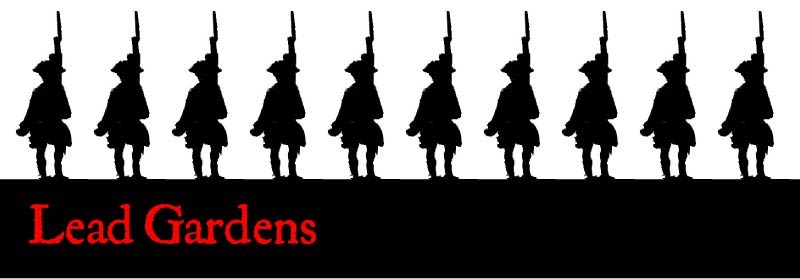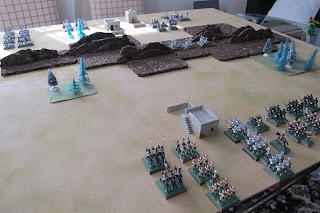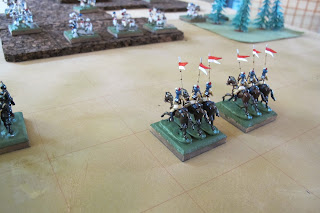 |
| basic buildings from floral foam topped with cereal box cardboard...a simple start, but lots of potential |
"Mind the Pennies" is the watchword here at the Lead Gardens these days and my latest emerging project is no exception. After having some nice success re-basing my colonial 20mm stuff and having a few recent battles using the "Portable Wargame" rules ...(thanks for all the encouragement guys!)... I came into a bit of "extra" funds to start another small project. I've been contemplating getting back into Spanish Civil War after a long (15 years) hiatus and the "Portable Wargame Rules have got me thinking that I could do two armies in 15mm relatively cheaply using the "Peter Pig" line of SCW minis and the look and scale of the rules would lend themselves to a good looking as well as an inexpensive game. So I fired off an order to the folks at Peter Pig this weekend and while I wait I'm going to work on terrain for Spain circa 1930s in keeping with the Portable Wargame table that I gridded off for my NW Frontier colonials. That means everything has to keep to a 2 1/2" grid square, and be fairly simple and inexpensive to produce. Though I do love the Hovels line that I used when I was doing SCW in 20mm (using the great Historical Products SCW line sculpted by David Allsop and still available from Pat Condray) way back when, and some of the JR miniatures buildings in 15mm are workable as well, I'm trying to reduce the cost of terrain to a bare minimum. Rather than go with my usual old school building approach,
(of buildings made of basswood or balsa, painted and the details drawn on), I thought that the SCW 15s might be better with a bit more detail in keeping with the figures and vehicles.
 |
| a coat of water putty for the walls and a layer of Liquitex ceramic acrylic for the roofs |
One of the things I have found in dealing with buildings on the game table over the years is that keeping the "footprint" of the buildings small is always good so as to not give away too much maneuvering space on what are usually for me limited sized tables. So my approach is to make the buildings a bit tall in relation to their width and depth. This does two things— it preserves the scale height so the figures and vehicles don't look too giant next to the buildings, and preserves the all important table real estate for deploying units.
 |
| a really quick and dirty Spanish village takes shape |
My "Portable Wargame" table is gridded into 2 1/2" squares so the buildings are going to have to fit within that dimension. This past Monday I was able to duck into my local craft outlet and I found some florist foam that was of a slightly higher density than what normally is used for flower arranging (usually the flower foam is way to soft for gaming purposes...) so I took a chance and bought three small blocks of the stuff thinking an experiment was in order.
 |
| the village church |
I was pleasantly surprised to find that the stuff was pretty sturdy yet cut really easily and I could make a balsa tool to press windows and doors into the foam building shape. The next step was to make the surfaces more durable and get a credible "pan tile roof" that would pass for Spanish buildings. I looked at many possible roof ideas including plastic molded sheet (not available in town)...stiffened corduroy fabric...maybe, but I didn't want to have to drive out to a fabric shop. While looking around our local art supply shop before heading in to work today, I found some "Liquitex Ceramic Stucco" acrylic paint which fit the bill perfectly. So that combined with some DAP water putty for coating the building faces, I was all set to make a quick, cheap and most importantly, a convincing Spanish village of the 1930s.
 |
| Liquitex textured acrylic solves the roof problem ($10.00 USD for the jar and the project only used a few tablespoons of the stuff) |
The DAP water putty adheres to the foam really well and stiffens the soft surface of the foam. I used thin cardboard from a cereal box to make the basic planes of the roof and used super glue to stick them to the basic building shapes. The "pan tiles" were created by spreading a thin layer of the Liquitex Ceramic Stucco acrylic and then using a "v notched" spreader to make the lines of the roof tiles. Once it had all dried the foam was both protected and stiffened to a reasonable sturdy finish (as long as nobody steps on them....)
 |
| The combination of textured acrylic and "V notched spreader" is the secret to making pretty convincing roof tiles |
Then came a stain of yellow ochre colored paint and red brown for the roof tiles and followed by some drybrushing....and in a day and a half I had a small village completed! (I did do a small bit of detailing on a few of the buildings using some textured plastic sheet for shutters...but the buildings look good even without that extra bit of work)
This weekend I'm planning to base these buildings on 2 1/2" square bases to help protect the undersides of the foam from damage, so hopefully the building will stand up to some use.
So I'm now thinking to make some vineyards and plowed fields with the remaining texture paint...and hopefully the figures will arrive in due time and I can get to painting up a new period. I hope to get this new project done before the fall semester begins and my teaching load ramps up again.
So I managed to get 6, 15mm buildings for less than $10.00 USD with just a couple of short working sessions over the past 2 days...I like those numbers!



















































